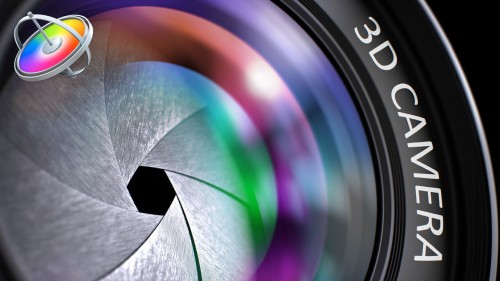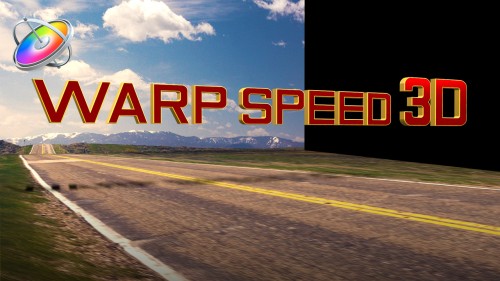- Publish 3D Objects to Final Cut Pro
- Convert & Modify 3D Objects
- Work with 3D Environments
- Animate 3D Objects and Cameras
- Track Objects using Final Cut & Motion
Using 3D Objects in Motion
$79.00
Convert & Modify 3D Models
What if you have a model you want to use but it’s not in the USDZ format required for Motion? We’ll show you how you can convert it using 2 different free applications. You can also use these applications to modify 3D models, including changing colors, removing components, changing opacity, and breaking models into separate pieces for animation in Motion.
Animate Separate 3D Elements
Once you’ve broken your 3D models into individual elements using free 3rd-party apps, we’ll show you how to import and reassemble those elements in Motion so that you can separately animate those elements to add more energy and realism to your scenes.
Fly Through Environments
Where things really get fun and interesting is when placing your 3D models into 2D environments that have been built from photos; or fully immersive 3D sets that you’ve downloaded from a stock site. In both cases, you’ll learn how to animate a camera through them to bring your scenes to life.
Replicate & Emit 3D Objects
And because 3D objects behave like any other object in Motion, Mark will have you replicating rocks and robots…and then creating swarms of fish using a particle emitter.
Using 3D Objects in Motion
1. Intro to 3D Objects in Motion
- Introduction
- Motion’s Library of 3D Objects
- Manipulating 3D Objects
- Environmental and Custom Lighting
- Adding Multiple 3D Objects
- Using Unit Size to Scale Objects
- Animated 3D Objects
- Orbiting by Changing Anchor Point
- Orbiting with the Orbit Behavior
2. Publishing 3D Objects to FCP X
- Working with Published 3D Objects in FCP X
- Installing the Free Published 3D Objects
- Animating a 3D Pin on a Map
- Animating a 3D Shape Object
- Color Correcting a 3D Shape Object
- Creating a Rigged Transition with 3D Objects
- Creating a 3D Lower Third Title
3. Importing Third Party 3D Objects
- Understanding USDZ
- Getting USDZ Models from Sketchfab
- Importing USDZ Models into Motion
4. Converting 3D Objects
- Other 3D Model Formats
- Getting Reality Converter
- Getting Blender
- Converting 3D Models with Reality Converter
- Converting 3D Models with Blender
5. Modifying 3D Objects
- Sketchfab Author Credit
- Adding Filters to 3D Objects and Layer Order
- Using Reality Converter to Extract a Color-Correctable File
- Changing the 3D Model Environmental Reflections
- Model Materials in Reality Converter
- Opening the Base Color Channel
- Modifying the Base Color Channel in Preview
- Modifying the Base Color Channel in Pixelmator
- Removing a Ground Plane in Reality Converter and Preview
- Swapping out 3D Objects in Motion
- Changing 3D Object Anchor Point in Blender
- Orienting a 3D Model in Blender
6. Animating 3D Objects
- Working with Pre-animated 3D Objects
- The Nature of 3D Objects in Motion
- Breaking Apart a Model with Selectable Components for Animation with Blender
- Reassembling the Racecar Model Components in Motion
- Fixing Component Anchor Points
- Animating Model Components
- Breaking Apart a Model without Selectable Components in Blender
- Orienting the Model in Blender
- Reassembling and Animating the Spitfire Model Components in Motion
7. Combining 3D and 2D Objects
- Positioning a 3D Object in a Scene with Orthogonal Views
- Adding a Background Color with Project Properties
- Creating an Environment with a 2D Group
- Creating a Floor for a 3D Scene
- Adding Walls to a 3D Scene
- Lighting a 3D Environment
- Adding Shadows 3D Objects in a Scene
- Adding Ambient Occlusion
- Using Clones of 3D Objects to Cast Shadows
- Adding a Lamp with a Light and Shadow
8. 3D Object Environments
- 3D Photogrammetry Environments from Sketchfab
- Scaling and Positioning the 3D Environment
- Adjusting the 3D Environment Model Anchor Point
- Positioning 3D Objects in the 3D Environment
- Impact of the Emissive Channel
- Using Local, World, and View Axes to Move 3D Objects
- Moving the Camera through the Completed Scene
9. Turning a Photo into a 3D Environment
- Reviewing the Environment and Camera Move
- Adding a 3D Model to the Photo Environment
- Positioning and Scaling the 3D Model to the Scene
- Alternative 3D Environment Design with Photos
10. 3D Objects & 3D Text
- Adding 3D Text to a Scene
- Styling 3D Text
- How 3D Text Interacts with 3D Objects
- 3D Text and Shadows
- Creating a Shadow Catcher for 3D Text
- Testing 3D Text Placement
- Completed Scene with Text and Camera Animations
11. 3D Objects and the Motion Path Behavior
- Project Elements
- How to Add the Motion Path Behavior to a 3D Object
- Getting a 3D Object to Turn Along a Motion Path
- Adjusting the Snap Alignment to Motion Behavior
- Changing 3D Object Built-in Animation Speed
- Adjusting Camera Angle of View
- Adding a Shadow for the 3D Object
- Forcing a Shadow to a Single Direction
- Choosing the Axes of Alignment
- Understanding Motion Path Sources
- A Motion Path in All Three Dimensions
12. 3D Objects and Replicators
- Creating an Asteroid Belt with a Replicator
- Creating Randomness
- Animating the Asteroids
- Replicating Drones in a 3D Environment
- Setting up the 3D Environment
- Adding the Animated Drone
- Replicating the Drone
- Randomizing Baked-in 3D Object Animation
- Scaling up the Drones with the Sequence Replicator Behavior
- Making the Drones Spin
- Using Multiple Viewports
- The Rendered Scene with Camera Animation
13. 3D Objects and Emitters
- The Animated 3D Object Particle Source
- Creating Particles and Adjusting the Emitter
- Adjusting the Anchor Point
- Dealing with Intersecting 3D Objects
- Making the Fish Swim
- Creating a Top View Animation
- A Right View Animation
- Active Camera View Animation
- Adding Random Motion
- Turning the Fish by Moving the Camera
- Turn the Fish with an Attractor
- Exchanging the Particle Emitter Source Object
14. Animating Cameras in 3D Scenes
- Lesson Assumptions
- The Problem with Moving the Camera to Orient the Scene
- Setting the Scene by Positioning the 3D Object
- Make the Camera and Objects the Correct Relative Scale
- Resetting the 3D Object Anchor Point Before Scaling
- 3D Unit Size and Anchor Point Relationship
- Choosing the Best Camera Type for Animation
- Finalizing the Tunnel Location
- Creating the Camera’s Motion Path
- Animating the Camera with the Motion Path Behavior
- Orienting the Camera’s Rotation Along the Motion Path
- Adjusting the Camera Motion Path
- Adjusting the Camera’s Far Plane
- Smoothing Camera Motion
- Adjusting Path Points in the Inspector
- Making the Camera Spin with Keyframes
- Viewing the Rendered Project
- Animating the Camera Position in X, Y, and Z
- Using the Motion Path Behavior with an Open Spline
- Keyframing Camera Position and Rotation
15. Using mTracker 3D in FCP X and Motion
- The mTracker 3D plugin
- Tracking the Scene
- Adding the Tracked 3D Text
- Pasting the Track Data
- Choosing the Object Location
- Revealing the Shadow+Reflection Catcher
- Modifying the Shadow Angle
- Modifying 3D Text Attributes
- Example of Tracked 3D Text in FCP X
- Adjusting Environmental Lighting on 3D Text
- Using Symbols to Create Tracked, Textured 3D Shapes
- Tracking a 3D Logo
- Modifying mTracker 3D Title Templates
- Tracking 3D Objects in FCP X
- Tracked 3D Object with Color Correction
- Combining Tracked 3D Text and 3D Objects
- Using mTracker 3D in Motion
16. Summary and Key Takeaways
- The Basics
- Working with 3D Objects in FCP X
- Converting & Modifying 3D Objects
- Adding Environments
- Combining 3D Objects & 3D Text
- Animating 3D Objects
- Animating Cameras
- Tracking 3D Text & Objects with mTracker 3D
- Thank you
Who this Tutorial is for:
This tutorial is for anyone who wants to integrate 3D models into their Motion and Final Cut Pro X workflows. A basic understanding of Motion and Final Cut Pro is required.
Software Version: Motion 5.4.6 or later; FCP 10.4.9 or later.
Run Time: 3 hours 43 minutes
Type of Tutorial: Intermediate
Project Media: The tutorial also includes project and media files for following along in Motion 5.
About the Author: Mark Spencer
15 reviews for Using 3D Objects in Motion
Related products
-
 Page load link
Page load linkUsing & Animating 3D Cameras in Motion
Jump into the director’s chair as you set up 3D scenes; frame your subjects; then dolly, sweep, pan and create fluid camera movement for your motion graphics projects.Rated 5.00 out of 5$59.00Sale!
Rigging & Publishing in Motion 5
Learn how to create custom titles, effects, transitions and generators in Motion 5, then publish them for use in Final Cut Pro X.Rated 5.00 out of 5$49.00Original price was: $49.00.$29.00Current price is: $29.00.
Warp Speed 3D in Motion
Warp Speed 3D in Motion is a project-driven tutorial that will get you up to speed quickly using Motion’s 3D toolset to create dynamic 3D animations to engage your viewers.Rated 5.00 out of 5$59.00[]We use cookies to enable the site's core functionalities. Please review our cookie policies in the Privacy Policy. Details OK, I understandFirst Party Cookies
These cookies are required for the site to perform its core functionalities. This includes cookies allowing you to securely log-in and log-out and make an order through our online shop.Third Party Embeds
These are cookies needed to optimize your experience on our website. This includes analytics cookies, cookies to run 3rd party services like videos, etc.Go to Top

Nick A. (verified owner) –
This is an incredibly useful series of tutorials and really well worth the (relatively modest) cost. Having often stumbled upon Ripple Training’s videos on YouTube, I’ve been impressed by the hosts’ clear and mercifully gimmick-free exposition. Mark touches on lots of areas that I’ve tentatively dipped my toe into (Blender, Reality Converter) and has emboldened me to explore these further. Ideally I would have Mark on permanent standby to answer my endless questions as they arise, but in the absence of this I do heartily recommend this course as the next best thing. Also, there are so many fantastically useful tips and shortcuts applicable to Motion in general, mentioned in passing. Hats off to Ripple training, and many thanks.
Liron C. (verified owner) –
Fantastic tutorial, as always. So thorough and all-encompassing. And I loved the summary and key takeaways video in the end. In fact, I’d love to have one for every tutorial. It creates a really great review of what we’ve learned over the course of usually several days and wraps it all up neatly. Thank you for always providing primo material!
Matthew W. (verified owner) –
An excellent introduction to the newly supported USDZ format in Apple Motion. Mark covers the creative potential of adding 3d objects into Apple Motion, which will give plenty of inspiration to Motion users. He also covers how to get around some of the current limitations, including hacks on how to add shadows and adjust parameters of USDZ models using third party application support.
I suspect and hope that this is just the start of Apple bringing much more 3D support and tools into the Motion platform, and this first intro forms the bedrock of future tutorials as functionality and creative possibilities expand. Until then, this tutorial ticks all the boxes in getting you up and running with 3D objects.
Thanks Ripple team, another awesome tutorial, and I’d be lost without all your great work
Matt
Leon M. (verified owner) –
I wanted to reach out to Ripple Training to complement them on their latest tutorial series. I bought “Using 3D Objects In Motion” to try to learn this complicated new part of Motion. Mark provided detailed but understandable segments and answered a ton of questions I had about this new area of my video world. I can honestly say that I didn’t understand every segment but will go back and take each segment again and try to duplicate each project as I go. Thanks to Ripple Training for yet another fabulous teaching tool. I could not have progressed in my editing skills without the resources of Ripple Training.
Gregory S. (verified owner) –
I was recommended to you but a FCP book author and I’m glad he did. I have TONS to learn but this was a great starting point. Thanks for such attention to detail.
John L. (verified owner) –
I felt like I was getting secrets of the ages listening to Mark. This tutorial, Using 3D objects in Motion, had everything I was hoping for. And Mark’s presentation is concise and full of all the instruction needed to not only do the effects but to know how and why as well. Thanks so much for making this available.
Kind Regards,
John L.
Martin T. (verified owner) –
I am just getting into 3D per see, but am really enjoying this course for ideas on using 3D in my work as well as how to use 3D objects more effectively.
Hong-Syuen C. (verified owner) –
Very easy to understand !
Brian L. (verified owner) –
This really was an A-Z guide for learning how to use 3D objects in Motion. As always, Mark does a really good job of explaining things and providing practical examples. This was a very timely training for me and it was easily worth the purchase price.
Craig T. (verified owner) –
Mark is a magician with Motion and proves it again in the “Using 3D Objects in Motion” tutorial. An excellent and informative tutorial!
Thank you
Craig T.
Steve C. (verified owner) –
Ripple Training always produces excellent tutorials. And “Using 3D Objects in Motion” is the latest one and it maintains the high standards that we expect from Mark and Steve!
Clint R. (verified owner) –
Mark is always a great presenter and thorough in his teaching. He is very engaging and always one step ahead….and he includes a lot of great shortcuts to streamline the process. This is an excellent tutorial and I highly recommend it!
Thanks,
Clint R.
Ruth C. (verified owner) –
I really appreciated this super helpful tutorial on using 3D objects in Motion, and bought it almost the moment it became available! Extremely useful tutorial, that made a rather difficult subject so much easier to understand! I so much appreciate these Motion tutorials by Ripple training, because of them, using and working with Motion has become very feasible, and my creative passion in life, that brings a smile from ear to ear when I work with it. I have all of Mark’s motion tutorials, as I find them very easy to understand and follow.
Jeff M. (verified owner) –
I seriously needed this! love to finally mix adobe dimension 3D objects into motion files is a game changer!
Leo V. (verified owner) –
““ Using 3D Objects in Motion” this is one of the better tutorials by Mark Spencer of Ripple Training the lessons are good to follow my compliments (5 Stars).
Kind Regards
Leo V.